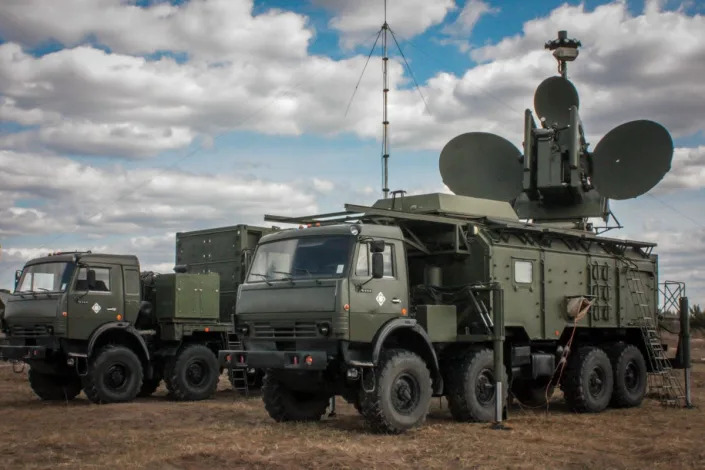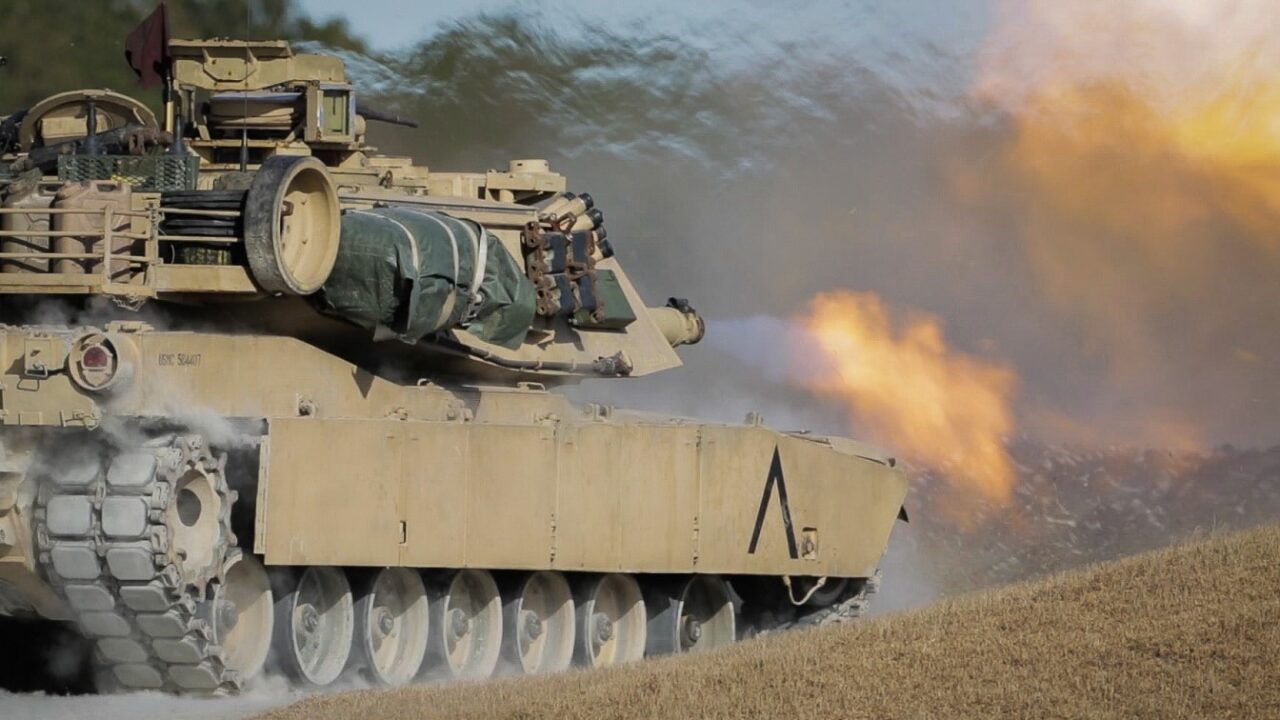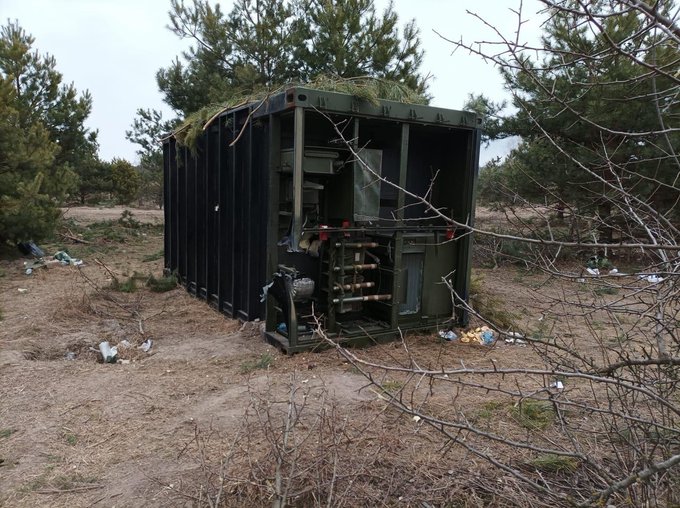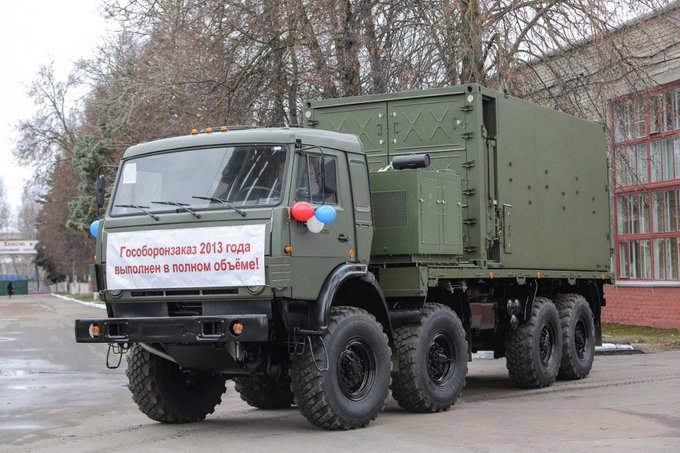Ukraine captures one of Russia's most advanced electronic warfare systems, which could reveal military secrets, reports say
Alia Shoaib
Sat, March 26, 2022

A Russian Krasukha-4 electronic warfare system.Mil.ru/Wikimedia Commons/Attribution
Ukraine has seized the command module of a Krasukha-4, one of Russia's most advanced electronic warfare systems.
The hi-tech unit was found abandoned on the outskirts of Kyiv.
Western spy agencies will examine it, say reports.
Ukrainian forces have seized part of one of Russia's most advanced electronic warfare systems, which could reveal its military secrets, reports say.
The Krasukha-4 command module was found abandoned on the outskirts of Kyiv partly damaged but otherwise intact, The Times of London reported.
Photos of the unit posted on social media appear to show the container containing the module covered in tree branches, possibly in a hasty camouflage attempt by retreating Russian forces.
Alia Shoaib
Sat, March 26, 2022

A Russian Krasukha-4 electronic warfare system.Mil.ru/Wikimedia Commons/Attribution
Ukraine has seized the command module of a Krasukha-4, one of Russia's most advanced electronic warfare systems.
The hi-tech unit was found abandoned on the outskirts of Kyiv.
Western spy agencies will examine it, say reports.
Ukrainian forces have seized part of one of Russia's most advanced electronic warfare systems, which could reveal its military secrets, reports say.
The Krasukha-4 command module was found abandoned on the outskirts of Kyiv partly damaged but otherwise intact, The Times of London reported.
Photos of the unit posted on social media appear to show the container containing the module covered in tree branches, possibly in a hasty camouflage attempt by retreating Russian forces.
The system is designed to jam low-orbit satellites, drones, and missiles, but it is also believed to be able to track NATO aircraft, The Times said.
Related video: How viral moments are shaping the war in Ukraine
A complete Krasukha-4 is a two-part system consisting of a command post module and an electronic warfare system, mounted separately on two trucks.
It is believed that a Krasukha-4 system was used against Turkish Bayraktar TB2 drones in Syria, interfering with their control signal and causing them to crash, according to The Telegraph.
The highly-rated Bayraktar TB2 drones are among those used by Ukrainian forces, used to destroy Russian tanks, armor, and truck convoys.
The seized unit will be examined by Western spy agencies, The Telegraph reported, adding that it would likely be taken by road to the US Air Force's Ramstein Air Base in Germany, before being flown to the US.
Examining the unit could reveal secrets of how it works, which could help Ukraine and Western allies render it useless on the battlefield.
Justin Crump, a military veteran and CEO of risk analysis consultancy Sibylline, told The Times that the seizure was among "lots of goodies that have been recovered on the battlefield."
"It shows how scattered the fighting is and the lack of communications on the Russian side," Crump told the paper.
By Sandboxx News

U.S. Marines assigned to 2nd Tank Battalion, 2nd Marine Division, fire a 120mm smoothbore main gun from an M1A1 Abrams main battle tank during a course of fire at Camp Lejeune, N.C., Jan. 30, 2019. The unit conducted marksmanship qualifications as a part of a biannual training exercise to certify tank crews on the M1A1 Abrams main battle tank.
(U.S. Marine Corps photo by Cpl. Abrey Liggins)
The US Military feated Russia’s tanks. Here’s why: In 1980, the U.S. Army had a terrifying vision: an armada of Soviet tanks sweeping across Western Europe, all the way to the English Channel. And the U.S. Army feared it had no weapons that could stop this vision from becoming a reality.
“In the arms likely to dominate the outcome of a future battle for Central Europe — armored fighting vehicles and counterweapons — the U.S. Army, then, probably will remain qualitatively and quantitatively inferior,” wrote U.S. Army Major General Paul Gorman in a secret 1980 study that wasn’t declassified until 2014.
The situation sounds eerily familiar to today, where critics question whether Russia’s next-generation T-14 Armata tank is superior to Western models. Or, whether U.S. and British anti-tank weapons will be effective against a Russian invasion of Ukraine that will rely on tanks for maneuver and firepower.
Throughout the Cold War, the United States accepted that its forces in Europe would be outnumbered by a massive Soviet war machine that by 1980 comprised 50,000 tanks — or five times the American tank arsenal. But U.S. leaders had always comforted themselves with the thought that Soviet numbers could be offset by superior American technology, training and tactics.
But by the end of the 1970s, when American military power had ebbed to its post-Vietnam low, Pentagon planners worried that the Soviet Union had achieved superiority in tank quality as well as quantity. In particular, they warned that the new T-72 outclassed the M60A1 and M60A3 — essentially upgrades of the 1950s M48 Patton — that were the backbone of the American tank arsenal at the time.
Even the first M1 Abrams tanks entering service — armed with the 105-millimeter cannon instead of the later 120-millimeter cannon — would have difficulty knocking out the more heavily armed T-72.
“The U.S. Army rates the best current Soviet tank clearly superior to its main battle tank,” the Army report warned.
It assessed the T-72 as superior to the M60A1 by virtue of superior firepower and armor protection. The T-72 was also believed to have numerous advanced features that the M60 lacked, including an “automatic electronic rangefinder, possibly laser rangefinder,” an autoloader to increase rate of fire, a snorkel to cross rivers without needing bridging equipment, and an anti-radiation liner to protect the crew from nuclear weapons. The Army did at least credit the M60 with carrying 60 rounds of main gun ammunition versus 40 for the T-72.
Nor could salvation be found in the anti-tank guided missiles that had begun entering service in the 1970s. Tests and mathematical modeling by the Army’s Ballistic Research Laboratory estimated that U.S. TOW and Dragon anti-tank missiles and the M-735 tungsten core round for the 105-millimeter cannon had a probability of kill (pK) as high as 77 percent against the front armor of a Soviet T-62 tank. But against the T-72, that probability dropped to as low as 22 percent, with even the upcoming M-774 depleted uranium round only having a 50 percent chance to kill a T-72 according to the worst-case models.
That meant defense against a tank-centric Soviet invasion of Europe would be difficult until the 120-millimeter-armed M1 arrived in the mid-1980s.
“Whether one uses informed U.S. or Soviet calculations, the conclusion is that NATO can expect, through 1984, no advantage over the Soviets in quality of armor or antiarmor weapons, and only a modest redressing of its present quantitative disadvantage,” the study concluded.
But were these dire predictions justified? It’s hard to be sure. While U.S.- and Soviet-made armor did clash in the 1973 and 1982 Arab-Israeli wars, a climactic — and perhaps apocalyptic — battle between American and Soviet armies never happened. Still, the much-vaunted T-72 seemed more of a paper tiger in the 1982 Lebanon War, when Israeli Merkava tanks armed with 105-millimeter guns disposed of them. And pitted against the Abrams in the First Gulf War, Iraqi T-72s seemed almost pitiful.
While Moscow could try to blame these debacles on the incompetency of their allies, or the fact that they were using inferior export models of Soviet equipment, that 1970s generation of T-72 tanks and MiG-23 fighters was not impressive in action. Even Syrian-manned T-90s may have been knocked out by U.S-made TOW anti-tank missiles supplied to Syrian rebels in 2016 and 2017.
As the Nazis with their Tiger and Panther tanks could attest, merely having the most powerful tanks doesn’t guarantee victory. Well-trained crews, flexible command and control, reliable logistics, and plentiful airpower are more important than the thickness of a tank’s armor.
In the end, that 1980 U.S. Army study seems less about the superiority of Soviet tanks, and more about the fact that U.S. tank design atrophied between 1945 and 1980. With defense dollars and priorities focused on nuclear weapons and chasing guerrillas through Asian jungles, tanks had become far from the most vital component of U.S. military power. It wasn’t until the M1 Abrams arrived in the 1980s that the U.S. could claim to have a cutting-edge tank, and arguably the best in the world. On the other hand, many Soviet tanks tended to resemble the 1950s T-55 (itself descended from the World War II T-34), which suggests that changes in tank design tend to be evolutionary rather than revolutionary.
Nonetheless, compare a Little Willie tank from World War I to an Abrams, and it’s obvious that tanks do change as technology progresses. Tanks inevitably change just as warfare does, and just as inevitable are the cries that the enemy’s tanks are superior. Fears that the Soviets had better tanks in 1980 are echoed today by warnings that the M1 and other Western tanks are inferior to the T-14 Armata, with its active protection system to shoot down anti-tank rockets, sophisticated sensors and data networking, and powerful 125-mm cannon housed in an unmanned turret while the crew remains safely cocooned inside the thickly armored hull.
For its part, the U.S. and other nations are developing new designs as well. The U.S. Army, for example, wants a family of armored vehicles that will include robot tanks. France and Germany are exploring a joint European tank that might feature a 140-millimeter cannon.
No doubt there will be Russian experts that will claim their tanks are inferior with these platforms enter service — and demand that the Kremlin fund the design of newer, better models (regardless of whether the T-14 has even entered production yet).
Michael Peck is a contributing writer for Forbes. His work has appeared in The National Interest, 1945, Foreign Policy Magazine, Defense News and other publications. He can be found on Twitter and Linkedin. This first appeared in Sandboxx News.
The US Military feated Russia’s tanks. Here’s why: In 1980, the U.S. Army had a terrifying vision: an armada of Soviet tanks sweeping across Western Europe, all the way to the English Channel. And the U.S. Army feared it had no weapons that could stop this vision from becoming a reality.
“In the arms likely to dominate the outcome of a future battle for Central Europe — armored fighting vehicles and counterweapons — the U.S. Army, then, probably will remain qualitatively and quantitatively inferior,” wrote U.S. Army Major General Paul Gorman in a secret 1980 study that wasn’t declassified until 2014.
The situation sounds eerily familiar to today, where critics question whether Russia’s next-generation T-14 Armata tank is superior to Western models. Or, whether U.S. and British anti-tank weapons will be effective against a Russian invasion of Ukraine that will rely on tanks for maneuver and firepower.
Throughout the Cold War, the United States accepted that its forces in Europe would be outnumbered by a massive Soviet war machine that by 1980 comprised 50,000 tanks — or five times the American tank arsenal. But U.S. leaders had always comforted themselves with the thought that Soviet numbers could be offset by superior American technology, training and tactics.
But by the end of the 1970s, when American military power had ebbed to its post-Vietnam low, Pentagon planners worried that the Soviet Union had achieved superiority in tank quality as well as quantity. In particular, they warned that the new T-72 outclassed the M60A1 and M60A3 — essentially upgrades of the 1950s M48 Patton — that were the backbone of the American tank arsenal at the time.
Even the first M1 Abrams tanks entering service — armed with the 105-millimeter cannon instead of the later 120-millimeter cannon — would have difficulty knocking out the more heavily armed T-72.
“The U.S. Army rates the best current Soviet tank clearly superior to its main battle tank,” the Army report warned.
It assessed the T-72 as superior to the M60A1 by virtue of superior firepower and armor protection. The T-72 was also believed to have numerous advanced features that the M60 lacked, including an “automatic electronic rangefinder, possibly laser rangefinder,” an autoloader to increase rate of fire, a snorkel to cross rivers without needing bridging equipment, and an anti-radiation liner to protect the crew from nuclear weapons. The Army did at least credit the M60 with carrying 60 rounds of main gun ammunition versus 40 for the T-72.
Nor could salvation be found in the anti-tank guided missiles that had begun entering service in the 1970s. Tests and mathematical modeling by the Army’s Ballistic Research Laboratory estimated that U.S. TOW and Dragon anti-tank missiles and the M-735 tungsten core round for the 105-millimeter cannon had a probability of kill (pK) as high as 77 percent against the front armor of a Soviet T-62 tank. But against the T-72, that probability dropped to as low as 22 percent, with even the upcoming M-774 depleted uranium round only having a 50 percent chance to kill a T-72 according to the worst-case models.
That meant defense against a tank-centric Soviet invasion of Europe would be difficult until the 120-millimeter-armed M1 arrived in the mid-1980s.
“Whether one uses informed U.S. or Soviet calculations, the conclusion is that NATO can expect, through 1984, no advantage over the Soviets in quality of armor or antiarmor weapons, and only a modest redressing of its present quantitative disadvantage,” the study concluded.
But were these dire predictions justified? It’s hard to be sure. While U.S.- and Soviet-made armor did clash in the 1973 and 1982 Arab-Israeli wars, a climactic — and perhaps apocalyptic — battle between American and Soviet armies never happened. Still, the much-vaunted T-72 seemed more of a paper tiger in the 1982 Lebanon War, when Israeli Merkava tanks armed with 105-millimeter guns disposed of them. And pitted against the Abrams in the First Gulf War, Iraqi T-72s seemed almost pitiful.
While Moscow could try to blame these debacles on the incompetency of their allies, or the fact that they were using inferior export models of Soviet equipment, that 1970s generation of T-72 tanks and MiG-23 fighters was not impressive in action. Even Syrian-manned T-90s may have been knocked out by U.S-made TOW anti-tank missiles supplied to Syrian rebels in 2016 and 2017.
As the Nazis with their Tiger and Panther tanks could attest, merely having the most powerful tanks doesn’t guarantee victory. Well-trained crews, flexible command and control, reliable logistics, and plentiful airpower are more important than the thickness of a tank’s armor.
In the end, that 1980 U.S. Army study seems less about the superiority of Soviet tanks, and more about the fact that U.S. tank design atrophied between 1945 and 1980. With defense dollars and priorities focused on nuclear weapons and chasing guerrillas through Asian jungles, tanks had become far from the most vital component of U.S. military power. It wasn’t until the M1 Abrams arrived in the 1980s that the U.S. could claim to have a cutting-edge tank, and arguably the best in the world. On the other hand, many Soviet tanks tended to resemble the 1950s T-55 (itself descended from the World War II T-34), which suggests that changes in tank design tend to be evolutionary rather than revolutionary.
Nonetheless, compare a Little Willie tank from World War I to an Abrams, and it’s obvious that tanks do change as technology progresses. Tanks inevitably change just as warfare does, and just as inevitable are the cries that the enemy’s tanks are superior. Fears that the Soviets had better tanks in 1980 are echoed today by warnings that the M1 and other Western tanks are inferior to the T-14 Armata, with its active protection system to shoot down anti-tank rockets, sophisticated sensors and data networking, and powerful 125-mm cannon housed in an unmanned turret while the crew remains safely cocooned inside the thickly armored hull.
For its part, the U.S. and other nations are developing new designs as well. The U.S. Army, for example, wants a family of armored vehicles that will include robot tanks. France and Germany are exploring a joint European tank that might feature a 140-millimeter cannon.
No doubt there will be Russian experts that will claim their tanks are inferior with these platforms enter service — and demand that the Kremlin fund the design of newer, better models (regardless of whether the T-14 has even entered production yet).
Michael Peck is a contributing writer for Forbes. His work has appeared in The National Interest, 1945, Foreign Policy Magazine, Defense News and other publications. He can be found on Twitter and Linkedin. This first appeared in Sandboxx News.



No comments:
Post a Comment